Wearing a Mask Helps Fight the Spread of Coronavirus
- Category: Health & Wellness, Infection Prevention
- Posted On:
- Written By: LVMC

The arrival of the novel coronavirus has introduced a cascade of concerns into modern-day society. At the forefront of these concerns is how to keep yourself safe while trying to navigate the new landscape of the world.
The U.S. Centers for Disease Control and Prevention (CDC) advises straightforward and specific steps you can take to prevent yourself from contracting the novel coronavirus. These measures include frequent hand washing, avoiding touching your eyes or face, maintaining a distance of six feet from other people (“social distancing”), and disinfecting surfaces frequently. Additionally, one of the most important tactics you can adopt to prevent the spread of the virus is routinely wearing a face mask outside your home, especially when you are in indoor public places.
Read on to learn more about how wearing a mask helps fight the spread of the coronavirus.
What We Know About the Coronavirus
The novel coronavirus, otherwise known as SARS-CoV-2, first appeared to be a primarily respiratory virus, similar to the influenza virus and other coronaviruses that cause conditions like the common cold. The virus originated in Wuhan, China, at the end of 2019 and quickly spread throughout the globe. Coronavirus appears to be more contagious than influenza, but less contagious than other notorious viruses, such as measles. Infection with the novel coronavirus can cause a multitude of symptoms. These symptoms generally appear within 2 to 14 days of exposure to the virus.
According to the CDC, the most updated list of symptoms of infection with the novel coronavirus, also known as a COVID-19 infection, includes the following:
 Fever or Chills
Fever or Chills
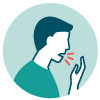 Cough
Cough
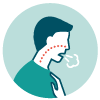 Shortness of Breath or Difficulty Breathing
Shortness of Breath or Difficulty Breathing
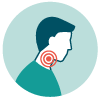 Sore Throat
Sore Throat
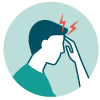 Headache
Headache
Other possible symptoms include:
- Fatigue
- Muscle or body aches
- New loss of taste or smell (known as “anosmia”)
- Nasal congestion or runny nose
- Nausea or vomiting
- Diarrhea
As you can see, many of the symptoms found to be associated with a novel coronavirus infection are not primarily respiratory. Many people who have had no respiratory symptoms at all have tested positive for the virus. Coronavirus has further perplexed the healthcare community because a large percentage of people who have tested positive have had no symptoms whatsoever; a condition is known as being “asymptomatic.”
How the Coronavirus Spreads
As it was initially thought to be a predominantly respiratory virus, we first understood novel coronavirus spread via respiratory droplets, which are small particles expelled when a person coughs or sneezes. These droplets can travel a few feet before falling to the ground. If people are standing close to each other, within a distance of six feet, for example, these droplets can travel and land in their eyes, nose, or mouth, possibly triggering an infection.
There is also a second way the virus may spread; because of its ability to exist on inanimate objects, it could be transmitted by touching an infected surface. For example, if a droplet was expelled from the cough of an infected person and then landed on a countertop. Then another person touched the countertop and proceeded to touch his or her face, then he or she could also contract the virus in this manner.
A growing number of scientists suggest the virus may also have an “aerosolized” component, meaning that particles even smaller than droplets can travel through the air at distances that are farther than previously thought. More research is needed, but if the virus is genuinely “airborne” in this way, it could very easily spread within enclosed spaces at distances farther than six feet from activities as simple as talking or breathing.
How Masks Can Help Fight the Spread of Coronavirus
The scope of the novel coronavirus is vast with a constellation of potential symptoms and severity of infections ranging from asymptomatic to deadly. This can be very intimidating and cause a great deal of health-related anxiety. However, wearing a mask is a significant way to help reduce the transmission of the virus.
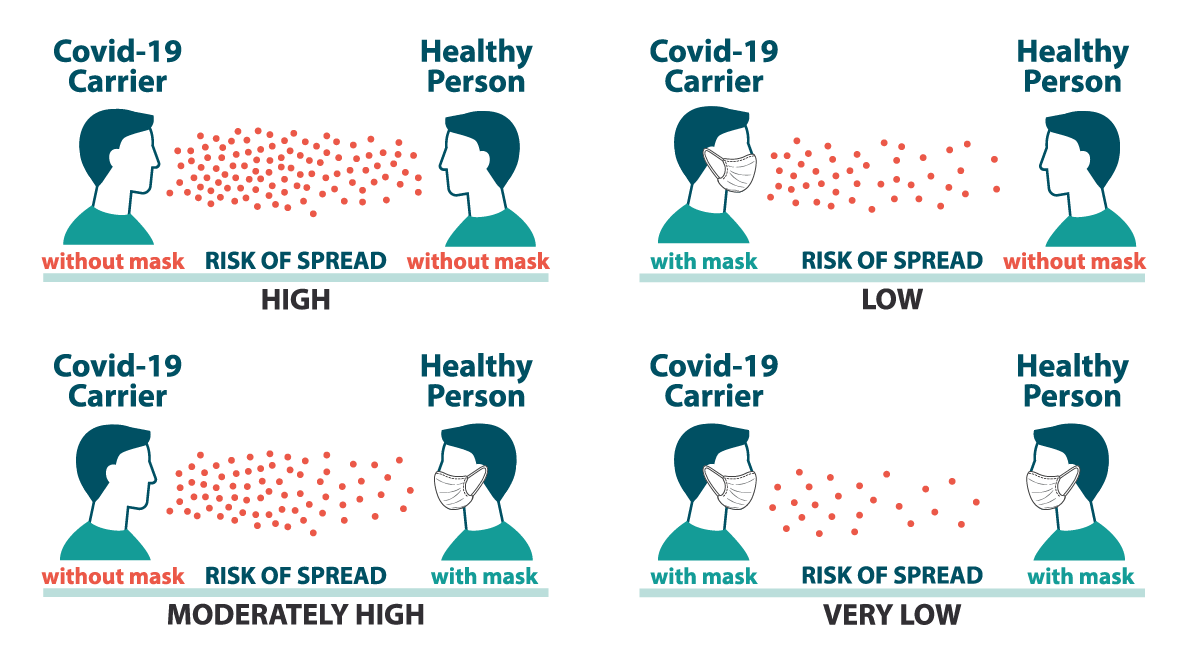
When you wear a mask, you minimize the droplet particles' ability to travel beyond your face and into your environment. Various studies have been conducted on just how much you can reduce the transmission of viral particles by wearing a mask. Still, the most up-to-date research on this topic has found that by merely wearing a homemade mask made of two layers of quilter’s cotton, you can reduce the distance particles travel to less than 3 inches from your face. This is extraordinary, given that, without a mask, droplets can travel six feet, or even farther.
On a public health scale, if everyone is wearing a mask and reducing their transmission of respiratory droplets, then the ability of the virus to spread from person to person will be significantly reduced. This is particularly important in enclosed indoor spaces where it is difficult to maintain the recommended social distance of six feet between people.
For healthcare providers, and other workers who face repeated, significant exposure to COVID-infected patients, unique masks are required that not only prevent the release of their respiratory droplets but also protect them from droplets entering their mask. These masks are known as “PPE,” one common type of which is an N95. The CDC does not recommend that the general population use medical-grade surgical masks, N95, or otherwise, as they offer no added protection in everyday interactions such as going to the grocery store, and supply shortages already exist.
Who Should Wear a Mask
Nearly everyone older than age two should consider wearing a face mask to prevent the spread of the novel coronavirus. The effectiveness of mask-wearing at a mass scale is strengthened when more people wear masks, similar to how vaccine campaigns are more effective when a greater percentage of the population gets vaccinated.
A mask may not be necessary if you are inside your own home, alone, or around other people with whom you spend all of your time and are not ill themselves. However, if you are venturing out into public spaces, particularly highly trafficked indoor spaces such as medical offices or grocery stores, you should wear a mask. If you are outdoors but in a densely populated area, such as an outdoor shopping mall or busy city corridor, it is advisable to wear a mask as well, as you could still spread respiratory droplets to others.
Who Should Not Wear a Mask
Children under the age of 2 should not wear a mask or any other type of facial protection (such as a face shield). According to the CDC, people who may have trouble breathing when wearing a mask, or who may have a health condition that would be worsened by wearing a mask, should not wear a mask. People who are unconscious or who would not be able to remove the mask themselves without assistance should also not wear a mask.
What Type of Mask to Wear
When it comes to the specific type of fabric that should be used for a face mask, the CDC suggests that a cloth facial-covering is sufficient. The mask must fit your face snugly, so there is little air leakage around the edges. You will also want to make sure the mask fits your face in a way that is tolerable for long periods, as fidgeting with the mask, and thereby frequently touching your face, can subject you to unwanted potential exposures to the virus.
The most up-to-date research on which type of homemade mask is most effective suggests that a double layer of quilter’s cotton, at a count of 70 threads per inch, is the most effective fabric for a face mask. This outperformed cloth handkerchiefs, bandanas, tea towels, and vacuum bags that were also included in the study. Quilter’s cotton even performed better than a preformed commercial cone mask, such as those available at your local drug store. For more information on mask types, and for a tutorial on making your own mask, check out the CDC’s tutorial.
Once you have made or acquired your own face mask, make sure to follow these tips from the World Health Organization about how to apply and remove the mask with each application safely.
What to Do If You Are Feeling Sick
Despite your best efforts, you may still become sick with the novel coronavirus, or another type of contagious infection. If you are feeling ill, it is important to stay home, contact your medical provider, and keep track of your symptoms. You can use the CDC’s symptom self-checker to do a self-assessment. At Lompoc Valley Medical Center, you can also have a visit with a healthcare provider from the comfort of your own home using our new TeleVisits service.
.png)
Luckily, most people who contract a COVID-19 infection do not have a severe course of illness and can recover at home with rest, hydration, and over-the-counter medications. However, if you or a loved one are experiencing severe symptoms, such as shortness of breath, chest pain, confusion, stroke-like symptoms, or an altered level of consciousness, call 911 or go to the emergency room as soon as possible. If you are unclear about whether your condition is emergent, or whether you may be better served at our urgent care facility, you can find more information about these facilities here.





